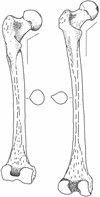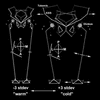The shape of the Neandertal femur is primarily the consequence of a hyperpolar body form
- PMID: 12761384
- PMCID: PMC165806
- DOI: 10.1073/pnas.1232340100
The shape of the Neandertal femur is primarily the consequence of a hyperpolar body form
Abstract
Neandertal femora are distinct from contemporaneous near-modern human femora. Traditionally, these contrasts in femoral shape have been explained as the result of the elevated activity levels and limited cultural abilities of Neandertals. More recently, however, researchers have realized that many of these femoral differences may be explained by the cold-adapted bodies of Neandertals vs. the warm-adapted bodies of near-modern humans. This study explicitly tests this proposed link between climate-induced body proportions and femoral shape by considering the entire hip as a unit by using geometric morphometric methods adapted to deal with articulated structures. Based on recent human patterns of variation, most contrasts in shape between the femora of Neandertals and near-modern humans seem to be secondary consequences of differences in climate-induced body proportions. These results, considered in light of hip mechanics during growth, highlight the importance of developmental and functional integration in determining skeletal form.
Figures




Similar articles
-
The anomalous archaic Homo femur from Berg Aukas, Namibia: a biomechanical assessment.Am J Phys Anthropol. 1999 Nov;110(3):379-91. doi: 10.1002/(SICI)1096-8644(199911)110:3<379::AID-AJPA9>3.0.CO;2-J. Am J Phys Anthropol. 1999. PMID: 10516568
-
The costal skeleton of Shanidar 3 and a reappraisal of Neandertal thoracic morphology.J Hum Evol. 2002 Mar;42(3):303-56. doi: 10.1006/jhev.2001.0528. J Hum Evol. 2002. PMID: 11846533
-
Biomechanics of the hip and birth in early Homo.Am J Phys Anthropol. 1995 Dec;98(4):527-74. doi: 10.1002/ajpa.1330980412. Am J Phys Anthropol. 1995. PMID: 8599386
-
Hominin Hip Biomechanics: Changing Perspectives.Anat Rec (Hoboken). 2017 May;300(5):932-945. doi: 10.1002/ar.23558. Anat Rec (Hoboken). 2017. PMID: 28406571 Review.
-
Rapid morphological change in living humans: implications for modern human origins.Comp Biochem Physiol A Mol Integr Physiol. 2003 Sep;136(1):71-84. doi: 10.1016/s1095-6433(02)00294-5. Comp Biochem Physiol A Mol Integr Physiol. 2003. PMID: 14527631 Review.
Cited by
-
Neonatal postcrania from Mezmaiskaya, Russia, and Le Moustier, France, and the development of Neandertal body form.Proc Natl Acad Sci U S A. 2016 Jun 7;113(23):6472-7. doi: 10.1073/pnas.1523677113. Epub 2016 May 23. Proc Natl Acad Sci U S A. 2016. PMID: 27217565 Free PMC article.
-
Femoral ontogeny in humans and great apes and its implications for their last common ancestor.Sci Rep. 2018 Jan 31;8(1):1930. doi: 10.1038/s41598-018-20410-4. Sci Rep. 2018. PMID: 29386644 Free PMC article.
-
Gradual decline in mobility with the adoption of food production in Europe.Proc Natl Acad Sci U S A. 2015 Jun 9;112(23):7147-52. doi: 10.1073/pnas.1502932112. Epub 2015 May 18. Proc Natl Acad Sci U S A. 2015. PMID: 26060299 Free PMC article.
-
Predicting the bending properties of long bones: Insights from an experimental mouse model.Am J Phys Anthropol. 2018 Mar;165(3):457-470. doi: 10.1002/ajpa.23363. Epub 2017 Nov 20. Am J Phys Anthropol. 2018. PMID: 29154456 Free PMC article.
-
Variation in cross-sectional indicator of femoral robusticity in Homo sapiens and Neandertals.Sci Rep. 2022 Mar 18;12(1):4739. doi: 10.1038/s41598-022-08405-8. Sci Rep. 2022. PMID: 35304879 Free PMC article.
References
-
- Boule, M. (1912) Ann. Paléontol. 7, 105–192.
-
- Weidenreich, F. (1941) Palaeontol. Sinica New Ser. D 5, 1–150.
-
- Trinkaus, E. (1993) J. Hum. Evol. 25, 393–416.
-
- Trinkaus, E. (1983) The Shanidar Neandertals (Academic, New York).
-
- Stringer, C. B. & Gamble, C. (1993) In Search of the Neanderthals: Solving the Puzzle of Human Origins (Thames and Hudson, New York).
Publication types
MeSH terms
LinkOut - more resources
Full Text Sources

